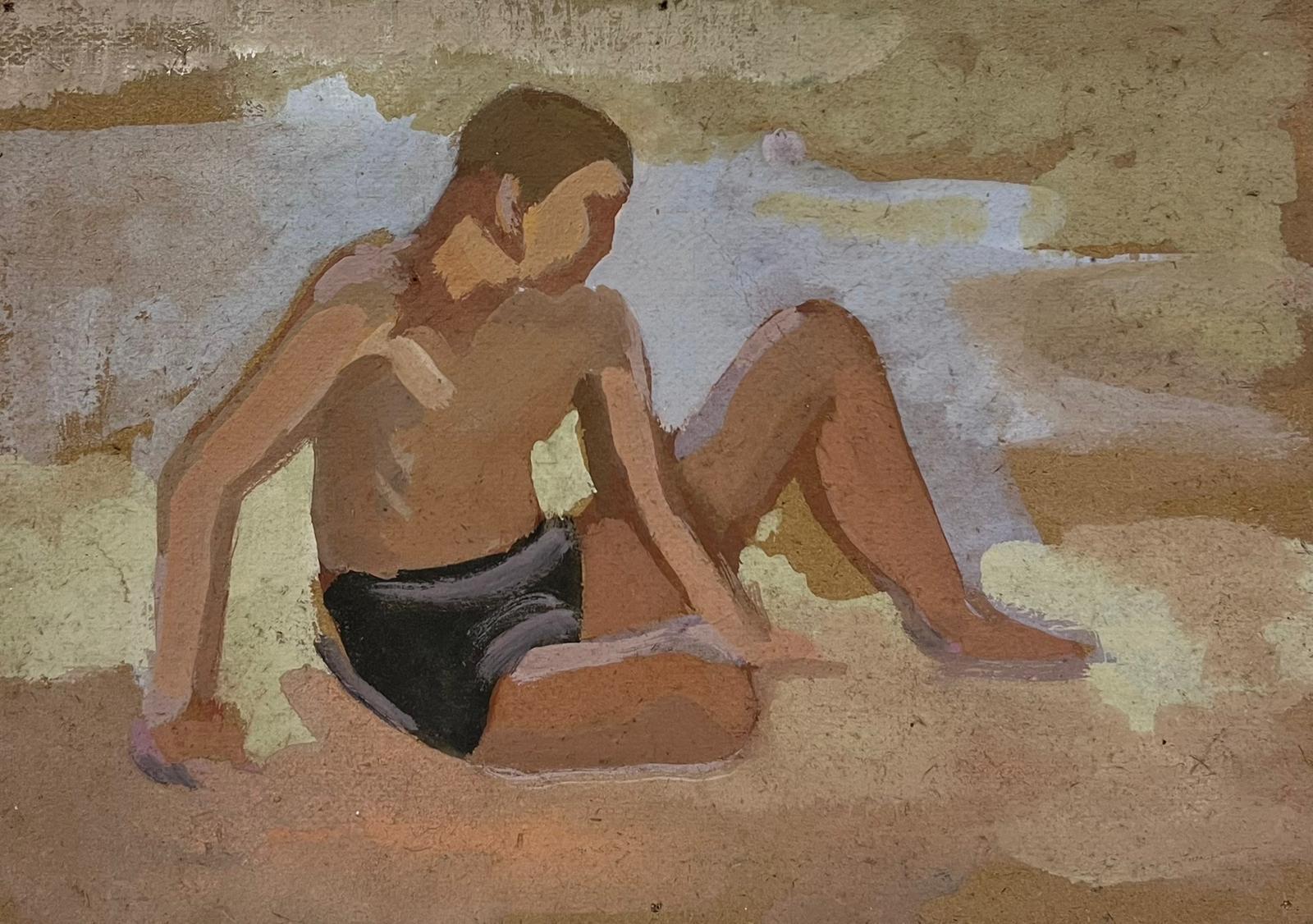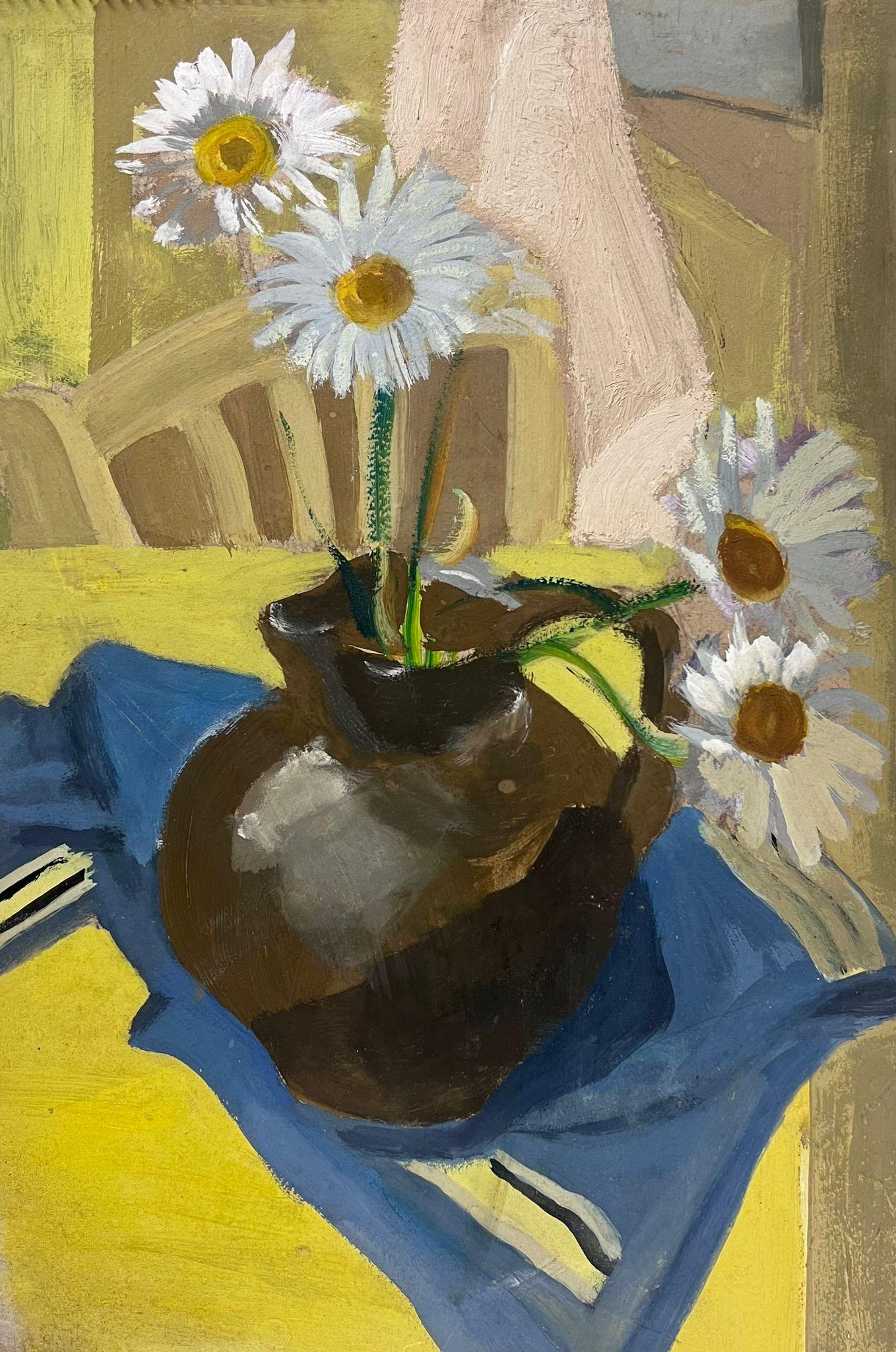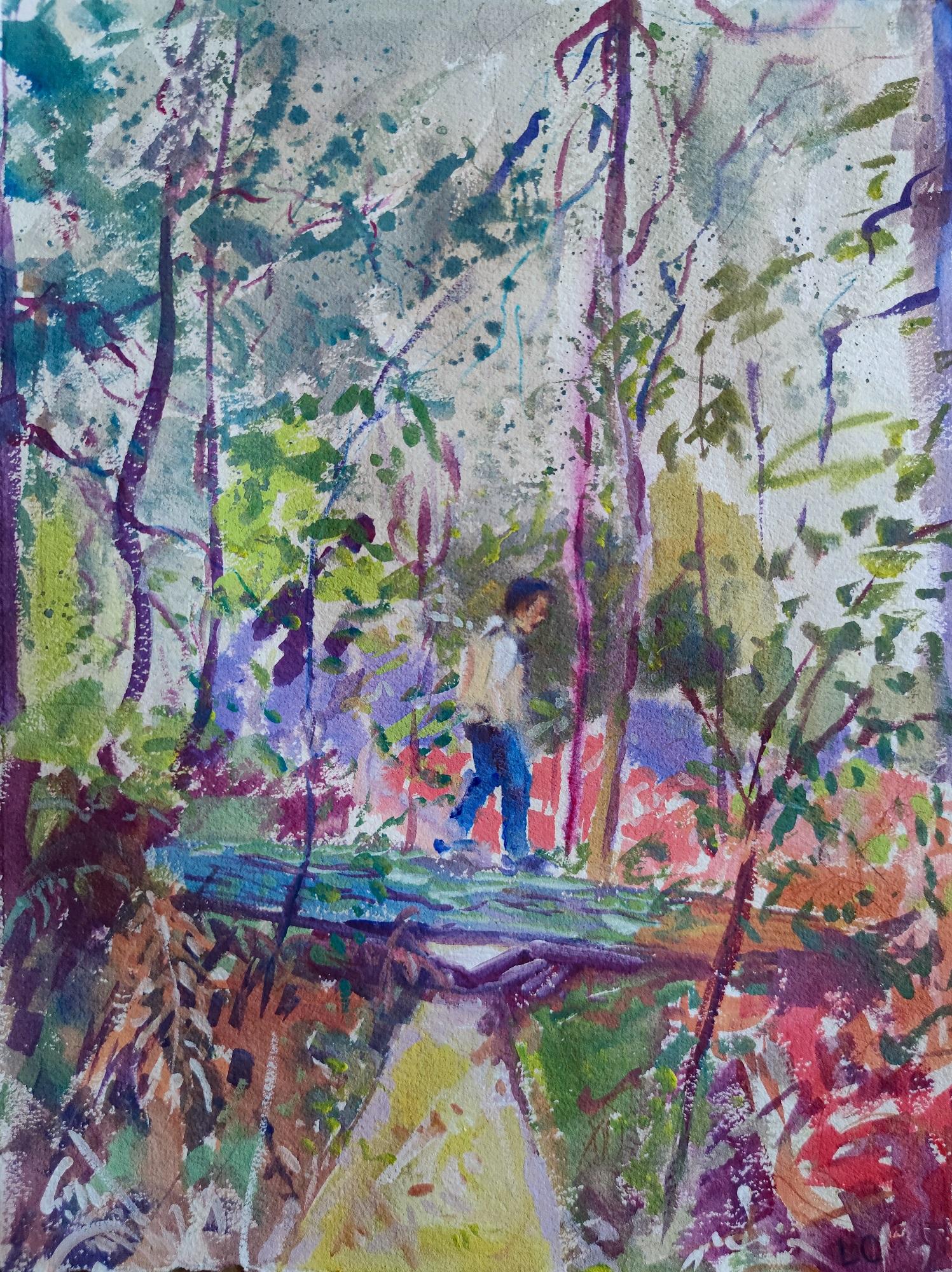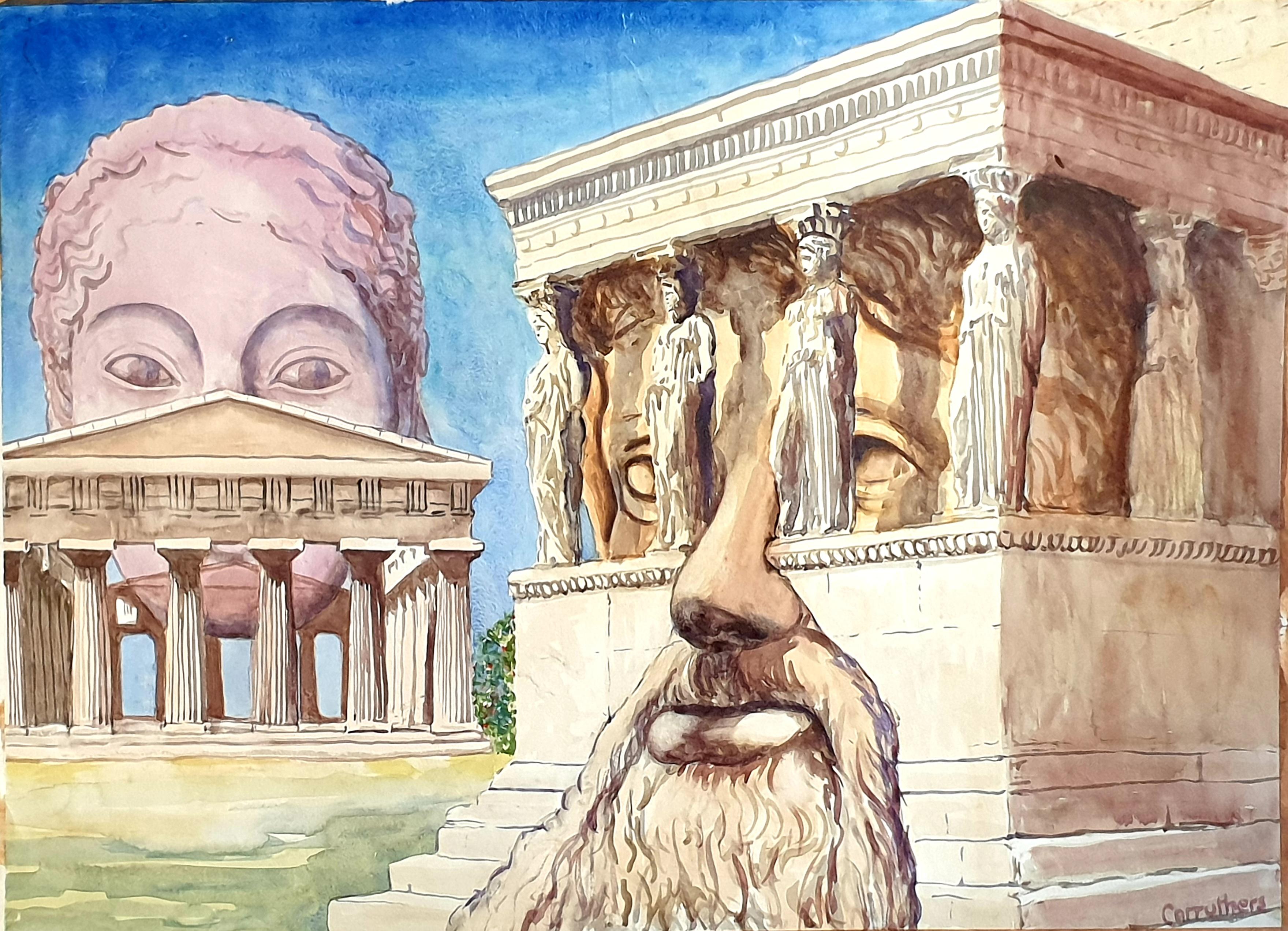Items Similar to Surrealist Gouache and Watercolour on Paper, The Three Graces
Video Loading
Want more images or videos?
Request additional images or videos from the seller
1 of 24
Derek Carruthers Surrealist Gouache and Watercolour on Paper, The Three Graces
About the Item
Late 20th century surrealist gouache and watercolour on paper of The Three Graces by British artist Derek Carruthers. The painting is signed to the bottom right.
An imposing and highly colourful painting of three heroic Graeco-Roman female figures in a classical pose in silhouette, back-lit by the moon. The remains of a temple are seen in the distance whilst in juxtaposition nature in great abundance flourishes at the feet of the three figures.
In Greek mythology, the Charites, or Graces, were three or more goddesses of charm, beauty, nature, human creativity, goodwill, and fertility. Hesiod names three – Aglaea ("Shining"), Euphrosyne ("Joy"), and Thalia ("Blooming") In Roman mythology they were known as the Gratiae, the "Graces".
Carruthers often loved to use strong imagery to pose questions and to challenge the viewer. Is this a commentary on the passing of time and the rise and fall of civilisations? The ruins of a once great civilisation are now pale and distant, the three figures have become faceless in their silhouette in a pose almost comforting eachother whilst nature goes on and surpasses us all.
A beautiful, thought provoking painting.
Carruthers likes to challenge our human perspective of what is normal. Using his constructivist approach to interlink art and architecture he takes images out of context or changes their relationship to each other either by manipulating size, juxtaposing images from different periods of time or by contrasting a beautiful background with its political or social meaning.
Derek Carruthers was an artist who persisted in asking questions. His whole career was inspired by the determination to enquire into the nature of art, examine its purpose, and attempt to explore that place where the individual life of the mind meets the external appearance of the world where personal sensation rubs up against cultural assumptions. Not surprisingly, Carruthers explored, over the years, a language of pure form, abstract space, 2 and 3 dimensions, narrative and concept, personal and universal figuration. Looking back, over decades of work, however, each of these voices is pursuing a coherent set of questions, reflecting on the stuff of human experience. Carruthuers’ individual pieces can intrigue and charm, they can be warm and poetic and they can also offer gritty resistance to the easy gaze. They can challenge us to think about ourselves, our environment, our expectations, our place in the world.
Carruthers grew up in the north-west of England having been born in Penrith, and one of his earliest memories of what art might be was formed by his encounter with the extraordinary creations of Kurt Schwitters. The latter had fled Germany in 1937, after his art had been labelled ‘degenerate’. He stayed, first, in Norway and then arrived in Britain in 1940. Carruthers had already encountered Schwitters' work as a boy, and had been launched on his own life-long examination of the nature of art.
Carruthers was further inspired by Victor Pasmore and Hamilton (British Constructivists) who were working closely together at King’s College London and eventually offered a challenging course to all first year students. Thus, Carruthers – who was at King’s in 1953 to 1957 was encouraged to take a rigorous approach to probing abstraction, spatial relationships, and the interlinking of art and architecture.
Having had the good fortune to have been an art student at such a time and in such a place, it is not surprising that Carruthers embarked on a voyage of artistic discovery. He showed his works with the major touring exhibition, organised by the Arts Council, in 1963, ‘Construction England’, together with Pasmore and Mary and Kenneth Martin.
His work was also included in exhibitions of new art at the Drian Galleries, Porchester Place, in 1963 to 1965. Reflecting the more recent re-examination of post-War, British Constructivism, Carruthers’ work was also included in the 1992 show, ‘British Abstract Art of the 50s and 60s’, held at the Belgrave Gallery. This early work, in which solid or relief forms change their nature as they – or the viewers – move through space and time, deliberately challenges the human tendency to find comfort in regarding the world as fixed and knowable.
In these years, too, Carruthers taught at Sunderland and Leicester Colleges of Art, before moving to lead the Fine Art course, as a Professor, at Trent Polytechnic (now the Nottingham Trent University). He was a dedicated educator, leaving to pursue his own art, full time, only in the mid 1980s.
Inspired, perhaps, by this freedom, the 1980s saw Carruthers exploring new ideas. He turned from working in 3-dimensions, or collage and relief, and rediscovered the power of traditional materials, oil and watercolour, on canvas and paper. He moved away from Non-Objectivity towards a practice which explored both abstracted and figurative imagery. Throughout, he remained preoccupied with exploring the human condition: by this trite remark, we mean that he continued to question how each individual experiences the world; he explored the ways in which human beings create totems to make their mark, as if to claim immortality; he tries to, ‘symbolise the triangular relationship between humankind and religion and the art / architecture which it inspires’. Hence - as well as warm glimpses of holidays and home life - his work yields the Egyptian pyramid, the Graeco-Roman heroic figure, the Christian monument; and, ultimately, the ‘sexless, ageless, raceless anonymity’ of the artist’s lay figure.
Derek Carruthers continued to ask questions, both about his life in a particular time and place, and about the lot of the human being on a universal scale. As an artist and a scholar, he saw himself at the intersection of these challenging states. And he makes you think........
- Creator:Derek Carruthers
- Dimensions:Height: 30.12 in (76.5 cm)Width: 22.25 in (56.5 cm)Depth: 0.04 in (1 mm)
- Medium:
- Movement & Style:
- Period:
- Condition:The bottom left margin of the paper is torn but has been taped and this does not encroach onto the image and will not show when framed (see photo).
- Gallery Location:Cotignac, FR
- Reference Number:Seller: GB/Carruthers/TheThreeGraces.1stDibs: LU1430214351932
About the Seller
5.0
Platinum Seller
These expertly vetted sellers are 1stDibs' most experienced sellers and are rated highest by our customers.
Established in 2000
1stDibs seller since 2020
163 sales on 1stDibs
Typical response time: <1 hour
- ShippingRetrieving quote...Ships From: Cotignac, France
- Return PolicyA return for this item may be initiated within 3 days of delivery.
Auctions on 1stDibs
Our timed auctions are an opportunity to bid on extraordinary design. We do not charge a Buyer's Premium and shipping is facilitated by 1stDibs and/or the seller. Plus, all auction purchases are covered by our comprehensive Buyer Protection. Learn More
More From This SellerView All
- Surrealist Gouache on Paper, 'Threshold or Pagans'.Located in Cotignac, FRContemporary surrealist watercolour and gouache on paper by British artist Derek Carruthers. Signed bottom right. An intriguing and beautifully pain...Category
21st Century and Contemporary Surrealist Landscape Paintings
MaterialsPaper, Gouache
- Surrealist Watercolour/Gouache on Paper. 'The Birth of Sculpture''Located in Cotignac, FRLate 20th century surrealist gouache and watercolour on paper by British artist Derek Carruthers. The painting is signed to the bottom right and title...Category
Late 20th Century Surrealist Landscape Paintings
MaterialsPaper, Watercolor, Gouache
- Crossing the Water. Mid 19th Century Realist Painting. Ecouen school.Located in Cotignac, FRMid 19th century Realist ink, watercolour and gouache portrait on paper of a young man in a field by John George Todd. The painting is signed G Todd bottom left as was his usual mann...Category
Mid-19th Century Realist Figurative Paintings
MaterialsWatercolor, Paper, Ink, Gouache
- A Very Bad Seagull, Contemporary Oil and acrylic on CanvasLocated in Cotignac, FRSurrealist contemporary oil and acrylic on canvas by Scottish artist Frank McLean Docherty R.S.W, signed and dated bottom left and signed and titled 'A Ve...Category
2010s Surrealist Figurative Paintings
MaterialsCanvas, Oil, Acrylic
- Réalisme Fantastique, L'Etabli, The Work Bench, Mid Century Fantasy SurrealistLocated in Cotignac, FRFrench, réalisme fantastique, Surrealist oil on board by Claude Verlinde. Signed and dated bottom left. Presented in plain wood frame with gilt filet. ...Category
1950s Surrealist Figurative Paintings
MaterialsPanel, Oil
- Large Surrealist Oil on Canvas. 'She brought Colour into his Life'.By Frank DochertyLocated in Cotignac, FRLarge surrealist contemporary oil on canvas by Scottish artist Frank McLean Docherty R.S.W, signed and dated bottom left and signed and titled 'She brought Colour into his Life' to the reverse. This piece whilst wonderfully colourful, playful and erotic is typical of the witty sense of humour this artist displays in all his work. Docherty likes to tease us visually and asks questions and presents conundrums to the viewer. Frank McLean Docherty was born in Glasgow , Scotland in 1942. He became a student at Glasgow School of Art in 1960 and graduated from the Department of Printed Textiles in 1964. He taught in a secondary school in the East End of Glasgow for two years, thereafter departing to work in Dublin in the Republic of Ireland as a textile designer (Marks & Spencer, Heals and Liberty of London). He was also an illustrator for a range of newspapers and an Art Director of magazines. In 1973, he was appointed Principal Teacher of Art in a Scottish High School and in 1978 was honoured by the Queen when he was appointed Member of the Royal Society of Painters in Watercolours (R.S.W.) He left education in 1994. Since that time he has developed a vision which is quite unique in Scottish Art. Bank Managers, toucans, lighthouses, penguins, bowler hats, Frank Docherty...Category
21st Century and Contemporary Surrealist Landscape Paintings
MaterialsCanvas, Oil
You May Also Like
- Tree of Life in the Garden - Visionary art by Tom FathBy Tom FathLocated in Soquel, CAExpressive Visionary Watercolor and Gouache painting of the Tree of Life by Tom Fath (American, 20th Century). Signed lower right "Tom Fath" and on verso paper backing. Exhibited: 20...Category
Early 2000s Surrealist Figurative Paintings
MaterialsGouache, Laid Paper, Watercolor
- Woodland Fancy, Mid-Century Fantastical Figurative Landscape 1969Located in Soquel, CAUnique and fantastical mid-century painting of a nude figure standing in front of a fish in the forest surrounded by flowers, plants, and a portrait by Kenneth Fong...Category
1960s Surrealist Figurative Paintings
MaterialsGouache, Paper
- Americana "For a horrible instant Carter thought the jet was going to crashBy Peter HelckLocated in Miami, FLMid Century Americana "For a horrible instant Carter thought the jet was going to crash in the street." Saturday Evening Post Work is framedCategory
1950s Surrealist Landscape Paintings
MaterialsGouache, India Ink
- Latvian Israeli Surreal Gouache Illustration Art Painting Tel AvivBy Maris BishofsLocated in Surfside, FLMaris Bishofs was born in 1939 in Rujiena, Latvia. In 1965 he became the first artist to graduate from the Latvian Art Academy with an interior design diploma. In 1972 he emigrated t...Category
1970s Surrealist Figurative Paintings
MaterialsGouache
- Bites of Trivial Matter- 3rd Panel in 6 Piece Series by Indian Artist Binay SinhBy Binay SinhaLocated in Gilroy, CA"Bites of Trivial Matter," is a six panel work by Binay Sinha, but each piece is also available for sale individually. The artist discusses modernity, specifically the effect in has ...Category
2010s Surrealist Figurative Paintings
MaterialsAcrylic, Watercolor, Handmade Paper
- Cotswold Landscape X, Rosie Phipps, Cotswolds, Landscape art, OxfordshireLocated in Deddington, GBCotswolds Landscape X by Rosie Phipps [2021] original and hand signed by the artist Water Colour Paint, Gouache and Pastel on Paper Image size: H:1...Category
21st Century and Contemporary Abstract Expressionist Landscape Paintings
MaterialsPaper, Watercolor, Gouache





